Abstract
Three normal subjects performed rest--exercise transitions on a cycle ergometer, from rest to unloaded pedalling (0 W), 50, 100 and 150 W. Each experiment was performed in triplicate, with randomized work load order, in two sessions. Ventilation was obtained breath-to-breath by integration of a pneumotachygraph signal, and cardiac output beat-to-beat by a new development of the Doppler technique. Results were bin-averaged in 4 s bins over the first 20 s, and compared to resting values. Both ventilation and cardiac output increased significantly in the first 2 s. This initial rise in ventilation was due entirely to an increase in rate, the subsequent rise mainly to increase in tidal volume. Cardiac output increased predominantly through change in rate with smaller increases in stroke volume. A striking feature was a tendency for ventilation and cardiac output responses to be biphasic with an initial rise followed by a slight fall at the 14 s mark, and a subsequent rise, at all work loads. Overall correlation between ventilation and cardiac output was therefore high (r = 0.92). Six normal subjects hyperventilated for 45 s voluntarily, (a) at rate 24/min and normal tidal volume; (b) at normal rate and tidal volume of 1.5 l; (c) at rate 24/min and tidal volume of 1.5 l. Cardiac output, averaged over 10-45 s, rose by 0.4, 0.5, and 1.0 l min-1 respectively, with falls in end-tidal PCO2 of 4, 6, and 8 mmHg. Six normal subjects hyperventilated for 60 s with rate 24/min and tidal volume of 1.4 l, and end-tidal PCO2 maintained at 38 +/-2 mm Hg. Cardiac output, averaged from 10-60 s, rose by 1.0 l min-1. With increased rate and tidal volume, whether isocapnic or hypocapnic, cardiac output responses showed an overshoot with a peak value at about 30 s. The hypothesis of 'cardiodynamic hyperpnoea' considers a possible effect of increasing cardiac output on ventilation. The effects of ventilation on cardiac output must also be considered. We propose an extended hypothesis involving stable positive feed-back.
Full text
PDF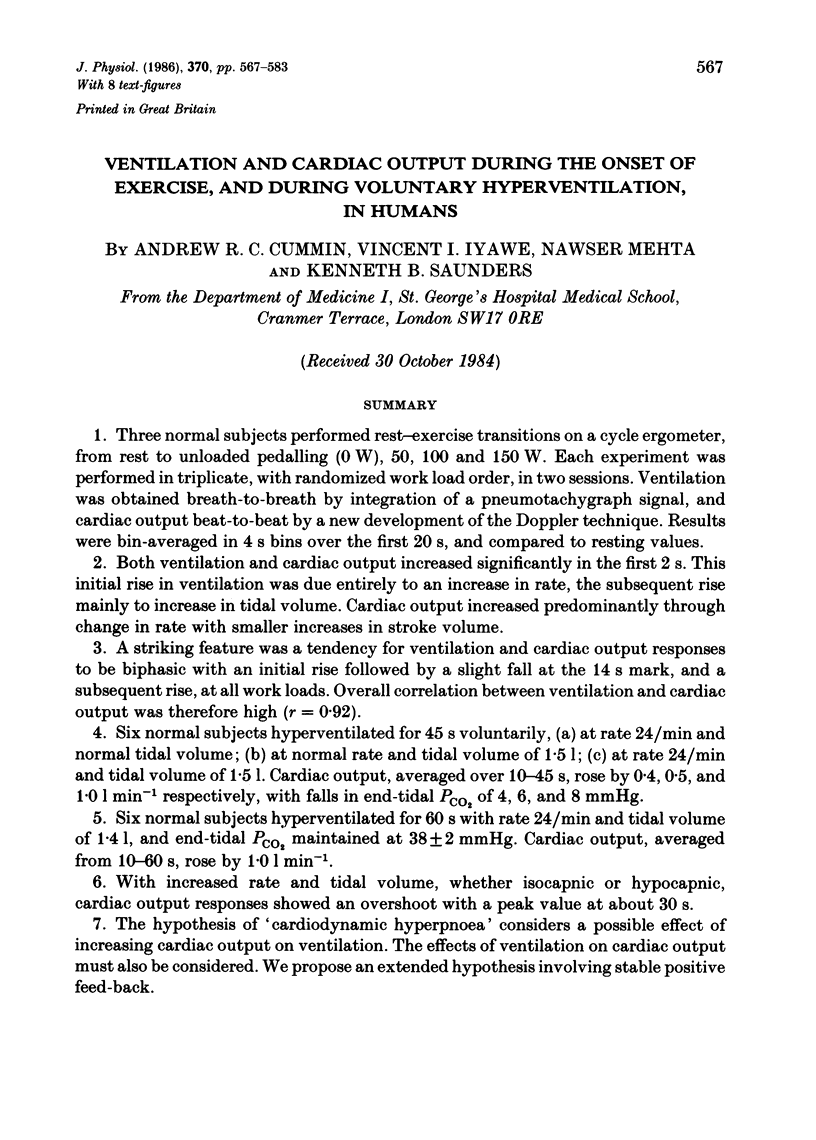

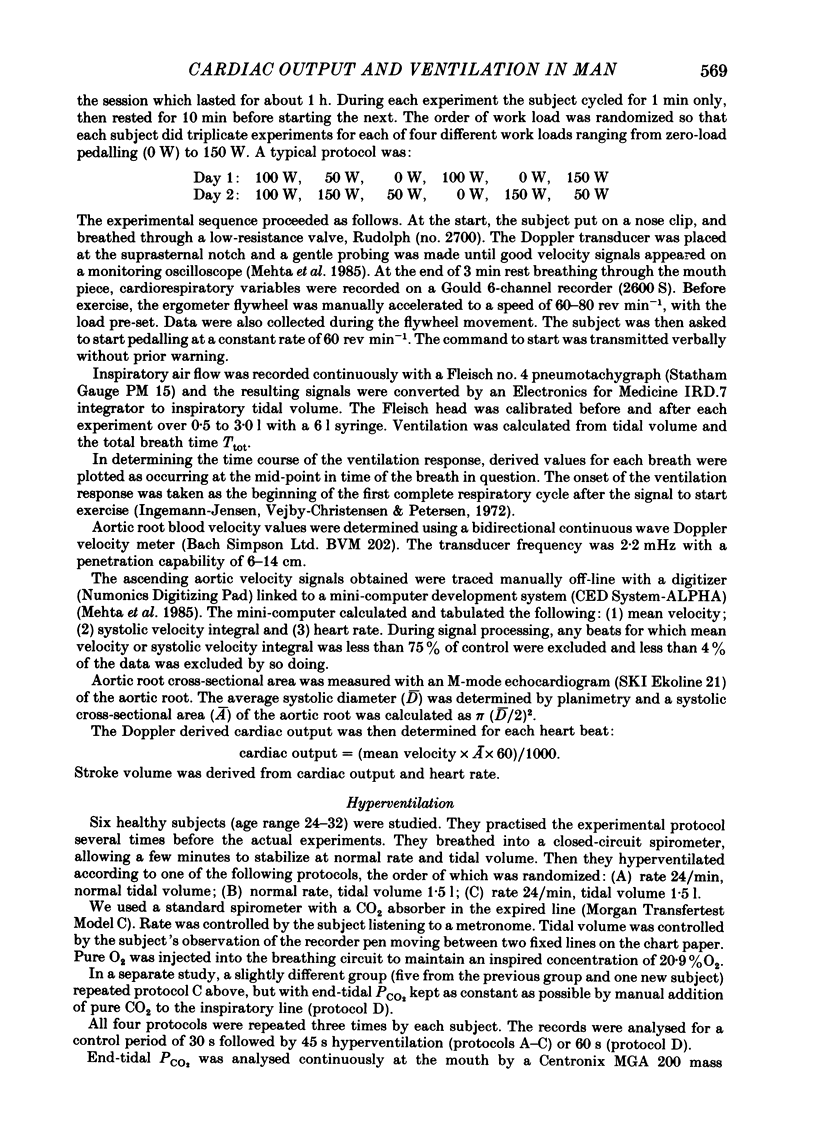
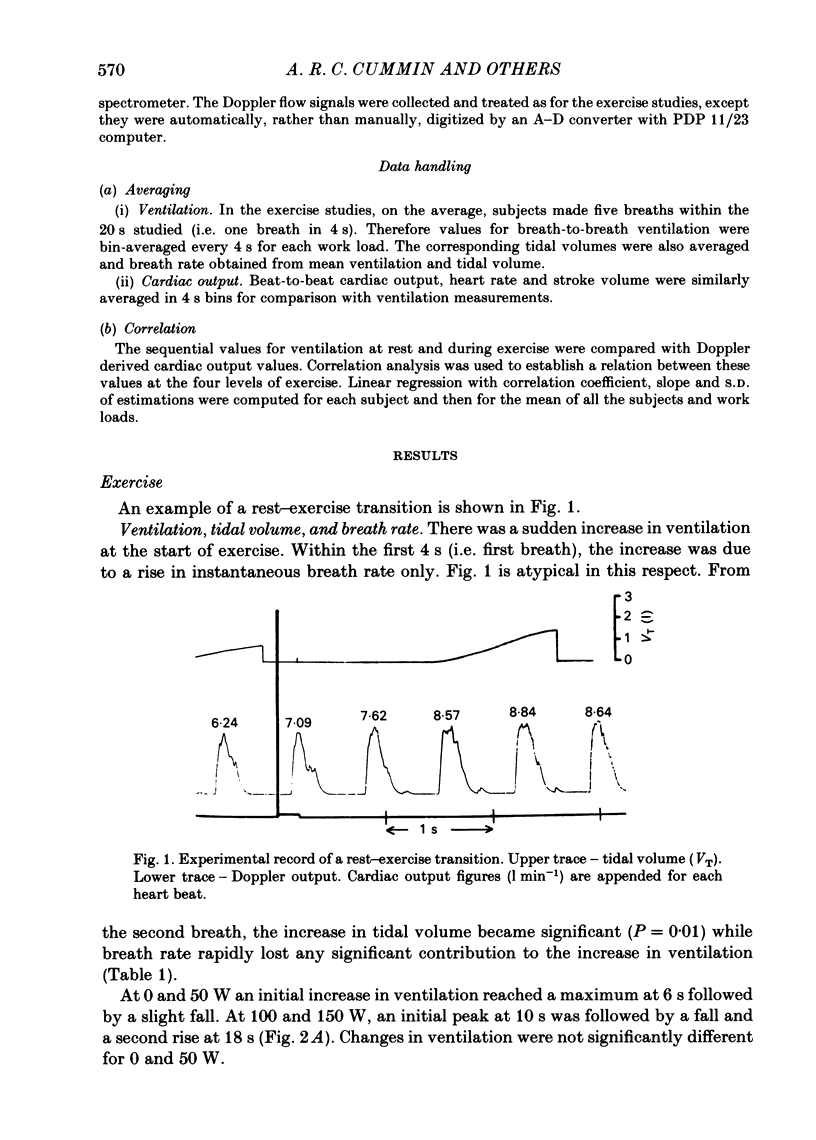

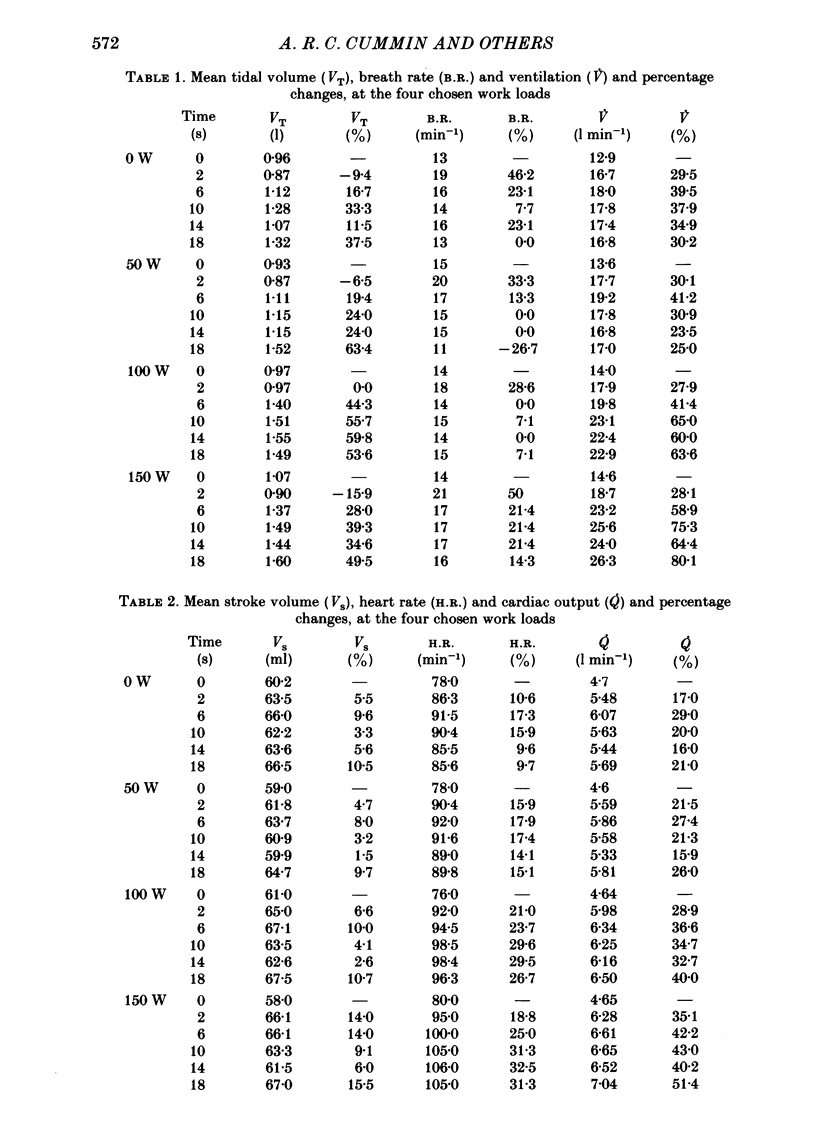


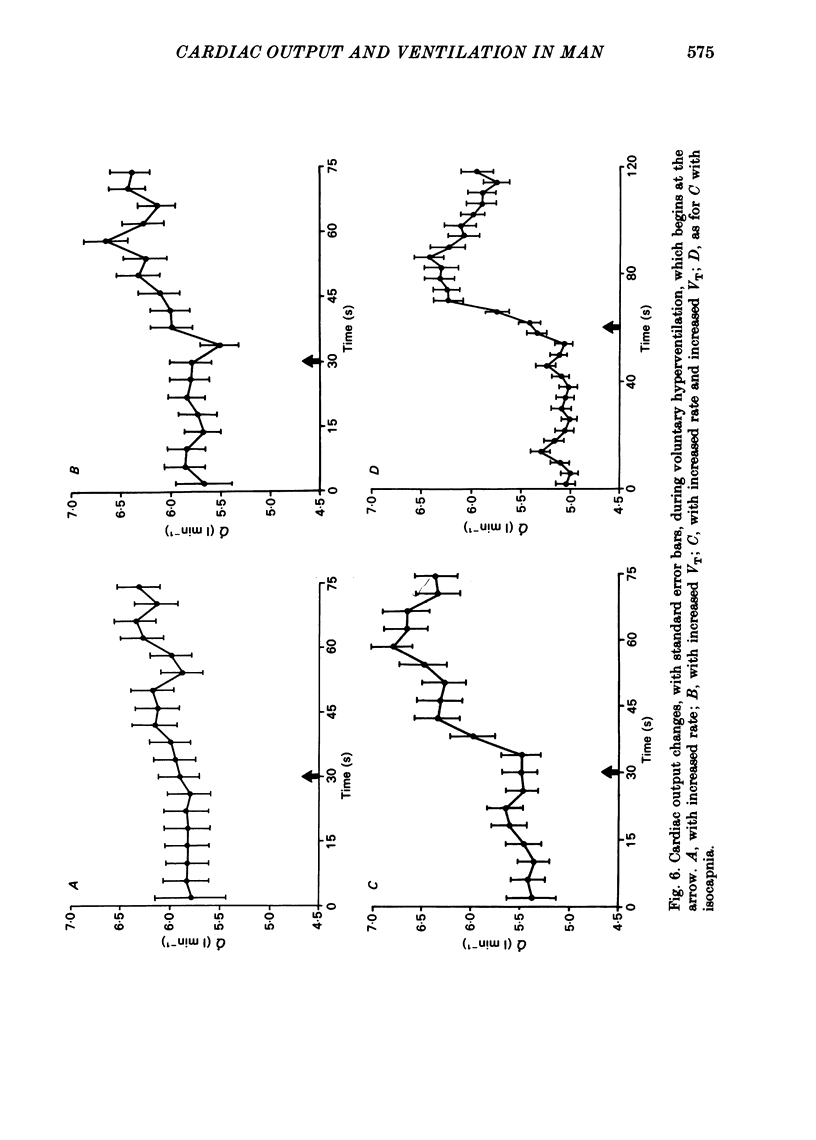
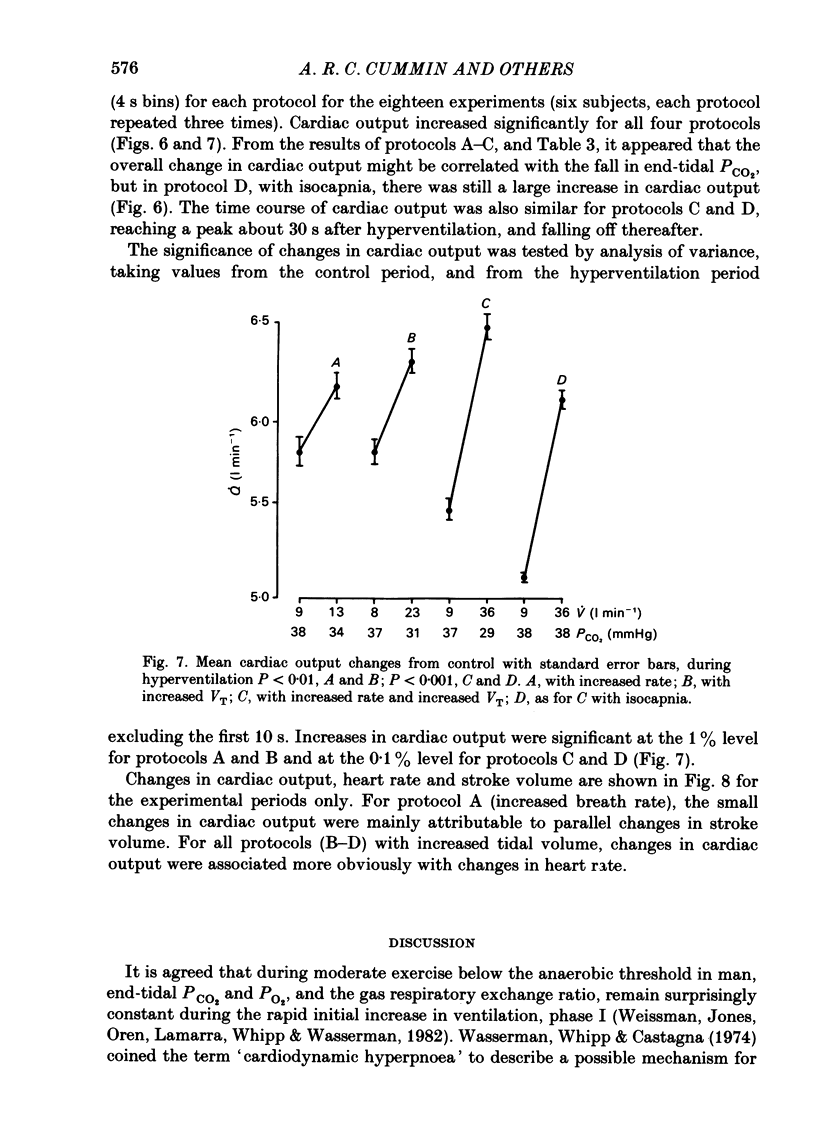

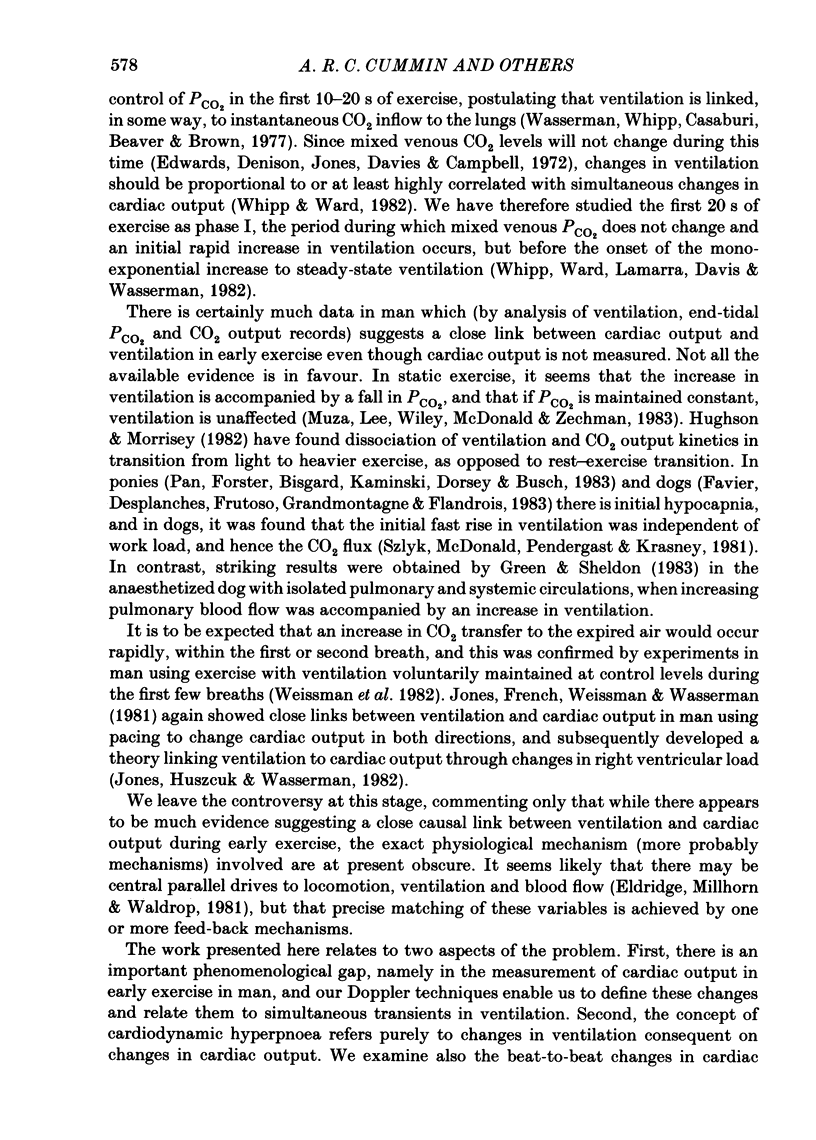
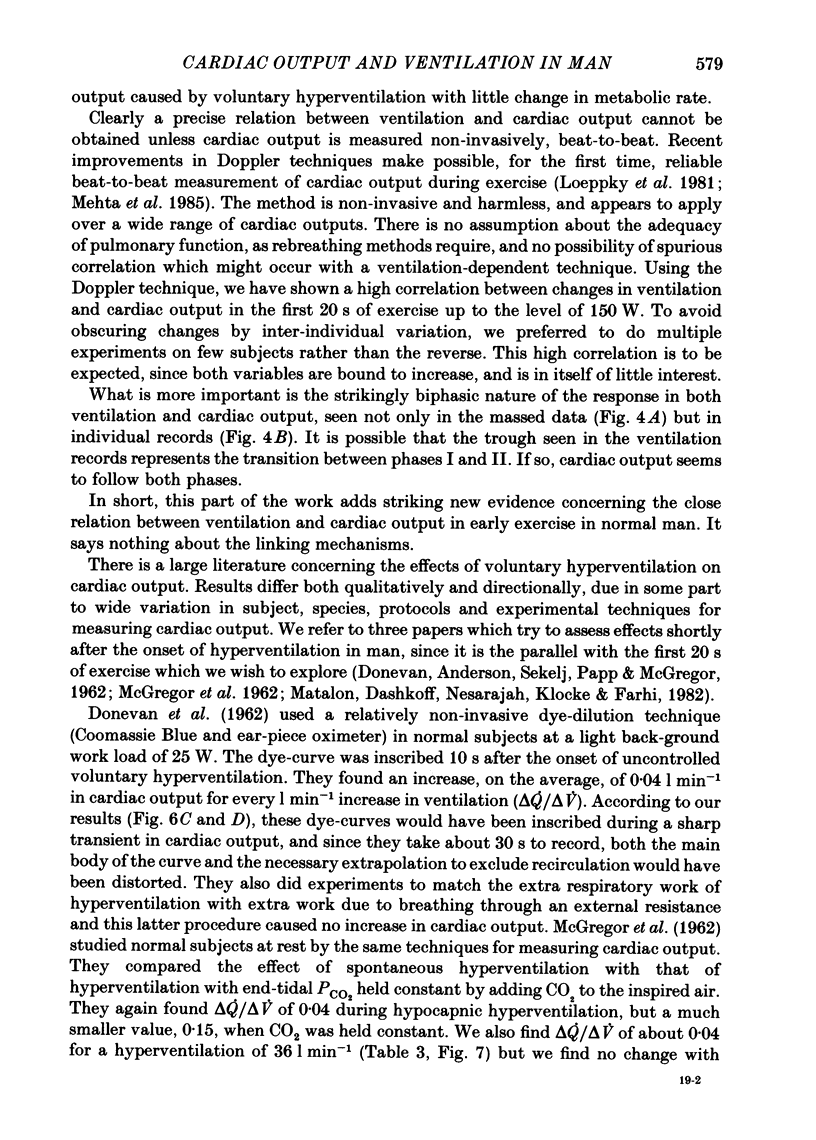


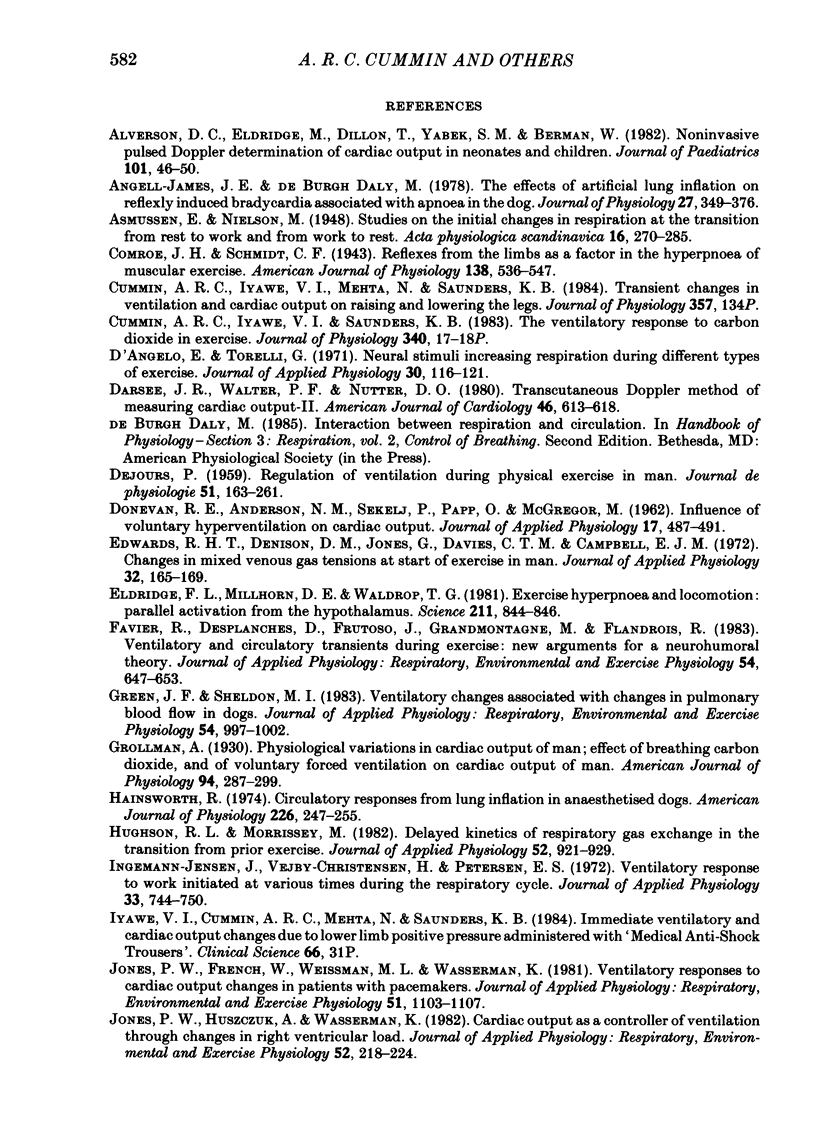
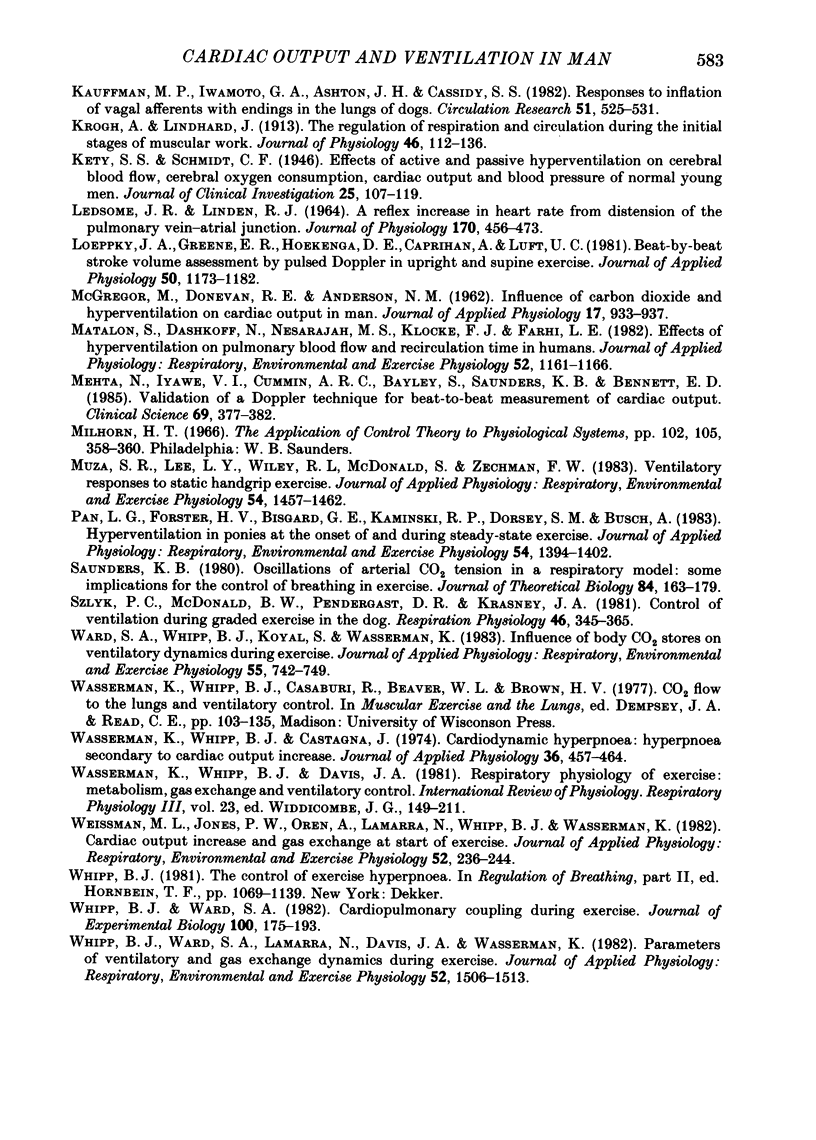
Selected References
These references are in PubMed. This may not be the complete list of references from this article.
- Alverson D. C., Eldridge M., Dillon T., Yabek S. M., Berman W., Jr Noninvasive pulsed Doppler determination of cardiac output in neonates and children. J Pediatr. 1982 Jul;101(1):46–50. doi: 10.1016/s0022-3476(82)80178-9. [DOI] [PubMed] [Google Scholar]
- Angell-James J. E., Daly M. D. The effects of artificial lung inflation on reflexly induced bradycardia associated with apnoea in the dog. J Physiol. 1978 Jan;274:349–366. doi: 10.1113/jphysiol.1978.sp012152. [DOI] [PMC free article] [PubMed] [Google Scholar]
- D'Angelo E., Torelli G. Neural stimuli increasing respiration during different types of exercise. J Appl Physiol. 1971 Jan;30(1):116–121. doi: 10.1152/jappl.1971.30.1.116. [DOI] [PubMed] [Google Scholar]
- DEJOURS P. La régulation de la ventilation au cours de l'exercice musculaire chez l'homme. J Physiol (Paris) 1959 Mar-Apr;51(2):163–261. [PubMed] [Google Scholar]
- DONEVAN R. E., ANDERSON N. M., SEKELJ P., PAPP O., McGREGOR M. Influence of vuluntary hyperventilation on cardiac output. J Appl Physiol. 1962 May;17:487–491. doi: 10.1152/jappl.1962.17.3.487. [DOI] [PubMed] [Google Scholar]
- Darsee J. R., Walter P. F., Nutter D. O. Transcutaneous Doppler method of measuring cardiac output--II. Noninvasive measurement by transcutaneous Doppler aortic blood velocity integration and M mode echocardiography. Am J Cardiol. 1980 Oct;46(4):613–618. doi: 10.1016/0002-9149(80)90511-1. [DOI] [PubMed] [Google Scholar]
- Edwards R. H., Denison D. M., Jones G., Davies C. T., Campbell E. J. Changes in mixed venous gas tensions at start of exercise in man. J Appl Physiol. 1972 Feb;32(2):165–169. doi: 10.1152/jappl.1972.32.2.165. [DOI] [PubMed] [Google Scholar]
- Eldridge F. L., Millhorn D. E., Waldrop T. G. Exercise hyperpnea and locomotion: parallel activation from the hypothalamus. Science. 1981 Feb 20;211(4484):844–846. doi: 10.1126/science.7466362. [DOI] [PubMed] [Google Scholar]
- Favier R., Desplanches D., Frutoso J., Grandmontagne M., Flandrois R. Ventilatory and circulatory transients during exercise: new arguments for a neurohumoral theory. J Appl Physiol Respir Environ Exerc Physiol. 1983 Mar;54(3):647–653. doi: 10.1152/jappl.1983.54.3.647. [DOI] [PubMed] [Google Scholar]
- Green J. F., Sheldon M. I. Ventilatory changes associated with changes in pulmonary blood flow in dogs. J Appl Physiol Respir Environ Exerc Physiol. 1983 Apr;54(4):997–1002. doi: 10.1152/jappl.1983.54.4.997. [DOI] [PubMed] [Google Scholar]
- Hainsworth R. Circulatory responses from lung inflation in anesthetized dogs. Am J Physiol. 1974 Feb;226(2):247–255. doi: 10.1152/ajplegacy.1974.226.2.247. [DOI] [PubMed] [Google Scholar]
- Hughson R. L., Morrissey M. Delayed kinetics of respiratory gas exchange in the transition from prior exercise. J Appl Physiol Respir Environ Exerc Physiol. 1982 Apr;52(4):921–929. doi: 10.1152/jappl.1982.52.4.921. [DOI] [PubMed] [Google Scholar]
- Jensen J. I., Vejby-Christensen H., Petersen E. S. Ventilatory response to work initiated at various times during the respiratory cycle. J Appl Physiol. 1972 Dec;33(6):744–750. doi: 10.1152/jappl.1972.33.6.744. [DOI] [PubMed] [Google Scholar]
- Jones P. W., French W., Weissman M. L., Wasserman K. Ventilatory responses to cardiac output changes in patients with pacemakers. J Appl Physiol Respir Environ Exerc Physiol. 1981 Nov;51(5):1103–1107. doi: 10.1152/jappl.1981.51.5.1103. [DOI] [PubMed] [Google Scholar]
- Jones P. W., Huszczuk A., Wasserman K. Cardiac output as a controller of ventilation through changes in right ventricular load. J Appl Physiol Respir Environ Exerc Physiol. 1982 Jul;53(1):218–224. doi: 10.1152/jappl.1982.53.1.218. [DOI] [PubMed] [Google Scholar]
- Kaufman M. P., Iwamoto G. A., Ashton J. H., Cassidy S. S. Responses to inflation of vagal afferents with endings in the lung of dogs. Circ Res. 1982 Oct;51(4):525–531. doi: 10.1161/01.res.51.4.525. [DOI] [PubMed] [Google Scholar]
- Kety S. S., Schmidt C. F. THE EFFECTS OF ACTIVE AND PASSIVE HYPERVENTILATION ON CEREBRAL BLOOD FLOW, CEREBRAL OXYGEN CONSUMPTION, CARDIAC OUTPUT, AND BLOOD PRESSURE OF NORMAL YOUNG MEN. J Clin Invest. 1946 Jan;25(1):107–119. doi: 10.1172/JCI101680. [DOI] [PMC free article] [PubMed] [Google Scholar]
- Krogh A., Lindhard J. The regulation of respiration and circulation during the initial stages of muscular work. J Physiol. 1913 Oct 17;47(1-2):112–136. doi: 10.1113/jphysiol.1913.sp001616. [DOI] [PMC free article] [PubMed] [Google Scholar]
- LEDSOME J. R., LINDEN R. J. A REFLEX INCREASE IN HEART RATE FROM DISTENSION OF THE PULMONARY-VEIN-ATRIAL JUNCTIONS. J Physiol. 1964 Apr;170:456–473. doi: 10.1113/jphysiol.1964.sp007343. [DOI] [PMC free article] [PubMed] [Google Scholar]
- Loeppky J. A., Greene E. R., Hoekenga D. E., Caprihan A., Luft U. C. Beat-by-beat stroke volume assessment by pulsed Doppler in upright and supine exercise. J Appl Physiol Respir Environ Exerc Physiol. 1981 Jun;50(6):1173–1182. doi: 10.1152/jappl.1981.50.6.1173. [DOI] [PubMed] [Google Scholar]
- Matalon S., Dashkoff N., Nesarajah M. S., Klocke F. J., Farhi L. E. Effects of hyperventilation on pulmonary blood flow and recirculation time of humans. J Appl Physiol Respir Environ Exerc Physiol. 1982 May;52(5):1161–1166. doi: 10.1152/jappl.1982.52.5.1161. [DOI] [PubMed] [Google Scholar]
- Mehta N., Iyawe V. I., Cummin A. R., Bayley S., Saunders K. B., Bennett E. D. Validation of a Doppler technique for beat-to-beat measurement of cardiac output. Clin Sci (Lond) 1985 Oct;69(4):377–382. doi: 10.1042/cs0690377. [DOI] [PubMed] [Google Scholar]
- Muza S. R., Lee L. Y., Wiley R. L., McDonald S., Zechman F. W. Ventilatory responses to static handgrip exercise. J Appl Physiol Respir Environ Exerc Physiol. 1983 Jun;54(6):1457–1462. doi: 10.1152/jappl.1983.54.6.1457. [DOI] [PubMed] [Google Scholar]
- Pan L. G., Forster H. V., Bisgard G. E., Kaminski R. P., Dorsey S. M., Busch M. A. Hyperventilation in ponies at the onset of and during steady-state exercise. J Appl Physiol Respir Environ Exerc Physiol. 1983 May;54(5):1394–1402. doi: 10.1152/jappl.1983.54.5.1394. [DOI] [PubMed] [Google Scholar]
- Saunders K. B. Oscillations of arterial CO2 tension in a respiratory model: some implications for the control of breathing in exercise. J Theor Biol. 1980 May 7;84(1):163–179. doi: 10.1016/s0022-5193(80)81042-3. [DOI] [PubMed] [Google Scholar]
- Szlyk P. C., McDonald B. W., Pendergast D. R., Krasney J. A. Control of ventilation during graded exercise in the dog. Respir Physiol. 1981 Dec;46(3):345–365. doi: 10.1016/0034-5687(81)90131-6. [DOI] [PubMed] [Google Scholar]
- Ward S. A., Whipp B. J., Koyal S., Wasserman K. Influence of body CO2 stores on ventilatory dynamics during exercise. J Appl Physiol Respir Environ Exerc Physiol. 1983 Sep;55(3):742–749. doi: 10.1152/jappl.1983.55.3.742. [DOI] [PubMed] [Google Scholar]
- Wasserman K., Whipp B. J., Castagna J. Cardiodynamic hyperpnea: hyperpnea secondary to cardiac output increase. J Appl Physiol. 1974 Apr;36(4):457–464. doi: 10.1152/jappl.1974.36.4.457. [DOI] [PubMed] [Google Scholar]
- Wasserman K., Whipp B. J., Davis J. A. Respiratory physiology of exercise: metabolism, gas exchange, and ventilatory control. Int Rev Physiol. 1981;23:149–211. [PubMed] [Google Scholar]
- Weissman M. L., Jones P. W., Oren A., Lamarra N., Whipp B. J., Wasserman K. Cardiac output increase and gas exchange at start of exercise. J Appl Physiol Respir Environ Exerc Physiol. 1982 Jan;52(1):236–244. doi: 10.1152/jappl.1982.52.1.236. [DOI] [PubMed] [Google Scholar]
- Whipp B. J., Ward S. A. Cardiopulmonary coupling during exercise. J Exp Biol. 1982 Oct;100:175–193. doi: 10.1242/jeb.100.1.175. [DOI] [PubMed] [Google Scholar]
- Whipp B. J., Ward S. A., Lamarra N., Davis J. A., Wasserman K. Parameters of ventilatory and gas exchange dynamics during exercise. J Appl Physiol Respir Environ Exerc Physiol. 1982 Jun;52(6):1506–1513. doi: 10.1152/jappl.1982.52.6.1506. [DOI] [PubMed] [Google Scholar]


